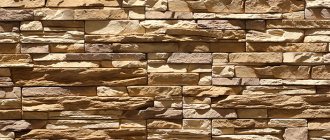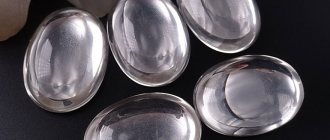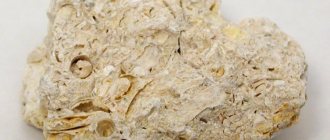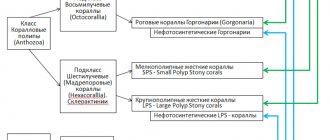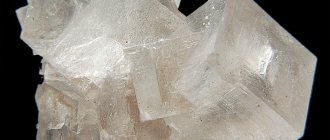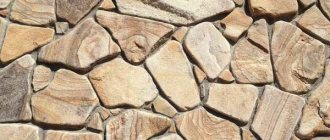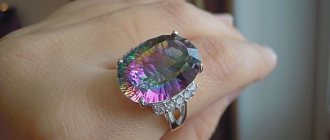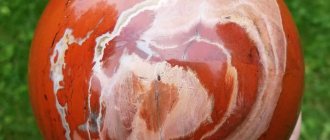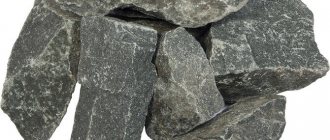| Category | Oxides (minerals) |
| Title in English | Pyrolusite |
| Formula | MnO2 |
| Group | Quartz group |
| Color | Black gray |
| Stroke color | Black |
| Shine | Matte, Metallic, Silky |
| Transparency | Opaque |
| singonia | Tetragonal |
| Hardness | 6 — 6,5 |
| Cleavage | Imperfect |
| Density, g/cm³ | 4,4 — 5,06 |
| Kink | Uneven |
| origin of name | Since ancient times, this mineral has been used to remove green and brown tints from glass. The name comes from the merger of two ancient Greek words - fire and washing. The symbiosis of these words forms the phrase “purifying by fire.” |
By its chemical nature, pyrolusite is a mineral of the manganese dioxide group. It has been familiar to humans for a long time, ever since it began to be used as a decolorizing agent in glass making. This property and branch of use of the stone is reflected in its name, which is translated from Greek as “the one that washes with fire” (“pir” means “fire”, “oluzis” translates as “to wash”). The description of pyrolusite and its scientific name was proposed by the Austrian scientist W. Haidinger in the mid-19th century. Before this, the stone was commonly known as polyanite or black magnesia.
Pyrolusite deposits
Pyrolusite deposits are typical for coastal areas of seas and lakes, but only in cases where the rock has access to oxygen.
In addition, deposits with hydrothermal origin of the mineral are known. — Advertising —
Pyrolusite deposits are formed under exogenous conditions. Deposits of the sedimentary type mineral are located in the Transcaucasus and Ukraine. In India and western Africa, pyrolusite is often formed during weathering processes. Czech mines are known for large crystals of pyrolusite. In Russia, in the south of the Urals, new deposits of this stone are being searched today.
In general, pyrolusite is also found in other countries, but is not a widespread mineral. Scientists have estimated that approximately 85% of the world's total manganese ore reserves are located in three deposits: Nikopol and Bolshetokmakovsky (Ukraine), and Chiatursky (Georgia).
Artificial production of mineral
It is obtained by thermal decomposition of some manganese salts in air, by oxidation of manganite with air oxygen and many other methods. It is formed from manganite when heated to 130° in air, from ramsdellite when heated to 310° for 5 days.
Diagnostic signs
Similar minerals . Magnetite. Pyrolusite often forms pseudomorphs after psilomelane, hausmannite, and manganite.
It differs from manganite, braunite and hausmannite in the color of its features; unlike psilomelans, vadov does not give the Faddeev reaction (it does not impart a pink color to a mixture of equal amounts of water and sulfuric acid when heated). The reflectivity of pyrolusite is much higher than that of manganite, so in polished sections it appears lighter; a yellowish or slightly brownish tint is characteristic compared to the grayish tint of manganite.
Associated minerals. Hematite, siderite, psilomelane, manganite, limonite, barite.
History of pyrolusite
The term "pyrolusite" is of Greek origin.
In Greek, "pur" means "fire" and "ioysis" means "to wash or wash." The combination of these two words, which indicate the ancient use of the mineral, gave the name to the stone. The thing is that pyrolusite was used in the process of bleaching glass. Pyrolusites, along with psilomelanes, are the main manganese ores. In fact, pyrolusite remains the main source for the industrial production of manganese. It is for this reason that it remains significant and important, although it has not found use either for magical purposes or in jewelry.
Origin and location
Pyrolusite is a mineral of predominantly sedimentary origin. Its accumulations are confined to areas of development of shallow-water sediments. It is also formed in oxidation zones of manganese-containing siderite deposits, developing along rhodonite and other manganese minerals.
Quite widespread. It is one of the most commonly found manganese minerals. It is formed mainly during the processes of hypergenesis. It was deposited in large masses in various geological epochs (especially in Tertiary time) in the coastal parts of sea and lake basins under conditions of access to oxygen. Mixed with psilomelane and partly with manganite, it forms the largest industrial deposits of manganese ores.
The mineral is resistant to change.
Physico-chemical characteristics of pyrolusite
— Advertising —
Pyrolusite consists of manganese oxide. It is characterized by a tetragonal system. The mineral is colored in shades of gray, steel, bluish-gray, dark gray or black. It is opaque, has perfect cleavage, uneven fracture and a metallic sheen.
The hardness of pyrolusite on the Mohs scale is from 2 to 6.5. The density is 4.7-5.08 g/cm3.
The special properties of this stone include the fact that it is a semiconductor and piezoelectric, soluble in hydrochloric acid. The blowpipe does not melt. Pyrolusite is also characterized by weak pleochroism and strong anisotropy.
The main form of pyrolusite is finely needle-like aggregates, cryptocrystalline earthy, powdery or sooty masses; in dendritic intergrowths it forms kidney-shaped aggregates, which are called “psilomelane”. Pyrolusite crystals with a good and clearly defined shape are very rare; they can be finely columnar or columnar.
Minerals associated with pyrolusite are braunites, hausmannites, hematites, goethites, hollandites, dolomites, manganites, calcites, rhodonites, rhodochrosites, siderites, chalcophanites, limonites, hydrogoethites, hydrohematites, lepidocrocites.
Chemical composition
Chemical theoretical composition: MnO2 - 100 (Mn - 63.19). Sometimes the content of adsorption and capillary water reaches several percent. Ba, alkali metals, etc. are contained as impurities. Powdery and dense pyrolusite often forms mixtures with other minerals.
Crystallographic characteristics
Syngony. Tetragonal.
Symmetry class. Ditetragonal-bipyramidal - 4/mmm (L44L25PC).
Crystal structure
Rutile lattice type lattice.
Main forms : Crystals from long to short prismatic along the c axis, also isometric. Sometimes there are needle-shaped crystals elongated along the c axis.
Types of pyrolusite
Several classifications are known for pyrolusite. According to the first of them, there are such varieties as:
- Polyanites are a rare subspecies characterized by euhedral, well-formed crystals with a Mohs hardness of 6.5 and a strong metallic luster.
- Vadas are pyrolusites, which are a soft, earthy mass colored dark brown or black when combined with other manganese oxides.
According to their origin and formation, pyrolusites are distinguished:
- Sedimentary - found in lakes, swamps, lagoons, estuaries with a high oxygen content and in conditions of low water circulation.
- Hydrothermal - formed under conditions of oxidation of hydrothermal solutions, which contain manganese compounds.
- Secondary - are formed during the oxidation of other manganese compounds.
- Synthetic - obtained by electrolysis of manganese compounds.
Form of being in nature
The appearance of crystals . Under an electron microscope, the shape of cryptocrystalline and earthy pyrolusite particles is varied: tabular, spherical, ellipsoidal, irregular.
Twins with twin planes (301) and (302) are rare. Polysynthetic twinning is observed in thin sections. X-ray diffraction patterns in samples from Baja California (Mexico) revealed parallel intergrowth with ramsdellite: a, (= a) and c of pyrolusite are parallel to a, b and c of ramsdellite, respectively [6]. In pseudomorphs of pyrolusite over manganite (100)'[001] pyrolusite || (100) [001] manganite [7]. When pyrolusite is replaced by braunite, both minerals have the same optical orientation [8].
Aggregates
Solid crystalline and cryptocrystalline masses, dense, loose, earthy or sooty. Characteristic are dendrites, crusts, oolites, concretionary, kidney-shaped and grape-shaped secretions (collomorphic and metalcolloidal). Among the compact, weakly crystallized masses, fibrous, finely columnar, radiant and granular aggregates are often observed.
The healing properties of pyrolusite
In modern lithotherapy, pyrolusite is used. It is believed that this stone has a positive effect on a person’s psycho-emotional state, helps to get out of depression, and has pain-relieving and wound-healing properties. In folk medicine, pyrolusite is also used to alleviate various diseases of the skin and joints.
Where is it used?
The stone has found application in practical industries.
Industrialists use it comprehensively:
- As a component of batteries and other galvanic devices.
- In the production of varnishes, paints, drying oils.
- As part of mixtures when processing hides.
- For decolorization of green and brownish glass raw materials.
Sometimes a synthetic analogue of the mineral is used.
For farmers, only natural minerals are important - as fertilizers in crop production.
In medicine, potassium permanganate (better known as potassium permanganate) is obtained from it.
Branches of application of pyrolusite
Pyrolusite is the main source of manganese ores, which is widely used in industry.
Thus, in glass production, pyrolusite is necessary for smelting colorless glass; for example, it effectively decolorizes green glass. The mineral is used in the manufacture of dry electric batteries and gas masks. The metallurgical industry produces ferromanganese and electroplating based on both natural and synthetic pyrolusite. The mineral is necessary in the production of steel alloys, white and mirror cast iron.
The chemical industry has found use for pyrolusite in the manufacture of paints and varnishes; it is used as a filler for drying oil and oil paint. Manganese salts and potassium permanganate are made from the mineral, which are necessary for the needs of the pharmaceutical industry.
In tanning processes, pyrolusite is necessary for tanning hides.
Finally, specimens of stones with a unique structure and amazing shades become the object of attention of collectors who literally hunt for such rare specimens and are willing to pay any money for them.
What is a stone
Typical pyrolusite looks like a black, gray (dark or bluish) crystal or dense mass no larger than a centimeter.
The structure depends on the formation conditions:
- Instances of “earthly” origin are needle crystals.
- A mineral of sedimentary or hydrothermal origin, which is formed in coastal zones, is loose and powdery.
Transparency is zero, the shine is metallic or dull.
On some samples a metallic tarnish of bluish tints is noticeable.
How to care for pyrolusite
Pyrolusite can vary in hardness, but is generally a brittle stone. For this reason, his rare collection specimens require very careful handling; they are protected from mechanical stress and cleaned only with a soft, damp cloth.
Crystal optical properties in thin preparations (sections)
Single axis (+). In polished sections it is white or grayish-white with a brownish or creamy tint. Reflectivity. very high for crystalline pyrolusite, according to Orcel and Pavlovich, Re - 39.7%, Ro = 29.5%; according to Ramdor (1955), it should be about 50-55% in ideal thin sections. The reflectivity of cryptocrystalline pyrolusite is significantly lower than that of clear-crystalline pyrolusite. Bi-reflection is strong: from light grayish-white (Ro) to lighter with a yellowish tint (Re). Strongly anisotropic (creamy yellow to violet-gray), especially strong in immersion.
Interesting facts about pyrolusite
- Scientists discovered pieces of pyrolusite in the Peches de Laze cave in southern France. It was suggested that Neanderthals used this stone as an oxidizer and a substance that accelerates the processes of combustion and oxidation.
- In ancient times, pyrolusite was called “black magnesia” and was used to brighten glass during its cooking (this eliminated the green tint that iron compounds give to glass). Pyrolusite was considered a subspecies of magnetic iron ores, and the fact that it is not attracted by magnets was explained by Pliny the Elder by the fact that black magnesia belongs to the female gender, and the magnet is indifferent to it.
Magical properties of the stone
Of the entire magical community, only Feng Shui adherents became interested in pyrolusite. They found that it was a stone of the Metal element.
It has been noted that the use of the mineral has a beneficial effect in the following aspects of life:
- Strengthening resolve.
- Increased self-esteem and creativity.
- Activation of entrepreneurial spirit.
- Staying calm in critical situations.
- Cutting off external negativity.
Pyrolusite is the guardian of the family hearth and marriage ties.
For the magic of the stone to work, it is placed in the office, bedroom, or meditation area. As an option, the western or northwestern segment of housing or office is suitable.
Stone products and price
The mineral is not used in jewelry.
The unique structure and amazing tones of pyrolusite attract collectors who try in every possible way to take possession of unusual large crystals, sparing no expense.
Pure pyrolusite crystals are rarely found on sale. Their price, depending on the size, ranges from $50-200 per copy. Samples of pyrolusite on other rocks, for example, quartzite, are cheaper. The price for a small stone like this usually does not exceed $20. The price of the industrial mineral is 3-5 $/kg.
Value to a person
Pyrolusite is the main manganese source. Its content in it is about 55−63%.
Manganese, in turn, is an essential substance for all living things. It plays a major role in the process of plant growth. It is one of the components of human and animal organisms. Manganese is necessary for normal liver function and the formation of long bones .
From the history of manganese dioxide
It has been known since ancient times. Researchers claim that this mineral was even used by Neanderthals . With its help, they made a fire and drew something like tattoos on their bodies. Although the second statement is speculative, since it is known that they used ordinary soot and coal from fires to decorate their bodies with drawings.
Guy Pliny was the first to pay attention to manganese dioxide, who mistook it for a type of magnetic iron ore.
The ancient Greeks used pyrolusite in making glass to remove iron impurities that gave it a greenish tint. Medieval alchemists called it “brown stone.”
And in 1774, the Swedish chemist Carl Scheele, combining pyrolusite and hydrochloric acid, isolated chlorine. He also became the discoverer of potassium permanganate.
Manganese dioxide was first described in detail in an article by Austrian geologist and mineralogist Wilhelm Heidinger in 1827.
